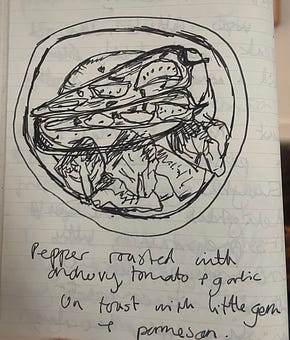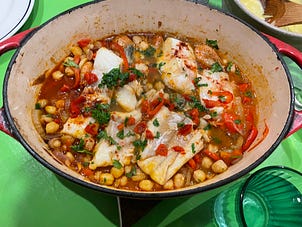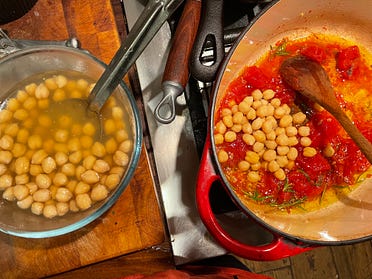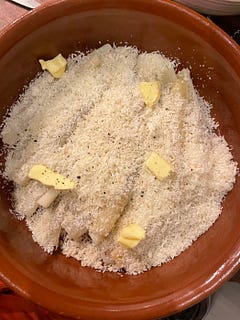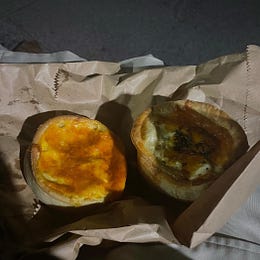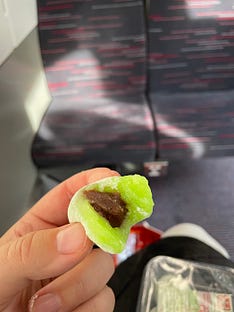Thank you for signing up to dinner document by Rebecca May Johnson! If you’d like to support my work, become a paying subscriber. Hello! My name is Rebecca May Johnson, I am a writer and cook and this is my Substack. This week’s newsletter is a note on reading Moyra Davey, diary entries about selling sweets and Hagelslag, two recipes for one and many, and eating notes. My first book SMALL FIRES, AN EPIC IN THE KITCHEN was published a few weeks ago. The book has received reviews in The Observer, The Sunday Times, the i Paper and The New Statesman. I am speaking about it on The Verb, on BBC Radio 3 this Friday evening 7 October at 10pm. And if you fancy coming along I am speaking to Katherine Angel tomorrow evening (Wednesday 5th October) at Waterstones on Gower Street. Fridges and Sweets I have just begun reading Index Cards, a book of essays by artist, filmmaker, and writer Moyra Davey. It has been sitting in a bright pink and white striped paper bag from the bookshop where I bought it for a several months, like a bag of uneaten sweets. I had wanted the book for some time, having watched her film Notes on Blue several years ago. The film begins with Davey removing her bra from underneath a t-shirt in her kitchen; she reads notes, pours gin, walks around an apartment, the kitchen, the bathroom, across a doorway. Early on, she cites a 1978 interview with German filmmaker Rainer Werner Fassbinder filmed in his apartment in Paris, who said, ‘“the more honestly you put yourself into the story, the more that story will concern others as well.” He makes a gesture towards qualifying ‘honestly’ but doesn’t dwell on it. His point is about the somewhat paradoxical notion of the very personal and intimate having a wide resonance.’ I saw the film when I was writing the proposal for the book I recently published, and it was one of many things that helped me write it in the way that I did, holding onto the significance of small movements, objects, and feelings. Despite the importance of the film to me, what swung the book purchase in the moment was seeing that the title of the first section was THE FRIDGE. And then, that not only was the title THE FRIDGE, but that it really was about a fridge and fridges, not a coy metaphor. The fridge becomes a lens through which Davey perceives other things. The book is situated in a fridge-centric universe. I was grateful, upon reading further, that we are brought back to a section titled THE FRIDGE at the end of the first essay, with a revised understanding of fridge-living, or seeing-through-fridges. * Selling sweets in the cinema last night. Two boys, maybe 10-11 years old. Each came up to buy sweets and drinks three times. First together, where each bought a different flavour of Aero chocolate (one mint, one orange) – called a ‘Shareo’ due to its larger than usual size. One paid cash from the bottom of his shoulder bag. He apologised for taking a few moments to find his coins. The other had a bank card and coolly tapped the machine. Then the other came up again and got a bag of popcorn. Then the other came to get something else. Then the other came up again five minutes later. I had thought they were with their families and perhaps were responding to orders sent from elsewhere. However, when we closed the shop and I left the refreshments booth, I saw that the boys were unaccompanied, and each of them had a pile of sweets and chocolate and popcorn and drinks at their feet. * My friend bought me a box of Hagelslag chocolate sprinkles from the Netherlands when she arrived off the ferry to stay the night. I mispronounced the name hackelschlackel when she presented them to me, and her son gleefully corrected me. Hagelslag!!! I said it incorrectly again, and he corrected me again, with gusto. It’s Hagelslag, Beccaaaa!!!!!!! My mispronunciation is a relic from childhood, when I ate them at the same friend’s house when we were nine or ten. In the last month I have eaten it with salted butter and sliced banana on toast; on top of apricot jam on toast (~Sachertorte edition); and on bread and butter. When a different friend stayed with me after travelling on the ferry from the Netherlands a few weeks later, I asked that she bring me another box of Hagelslag so that I did not run out, and she brought a slightly different type. Apparently there are aisles of choice in the supermarkets there. I tweeted a photo of Hagelslag on bread and butter and people responded with enthusiasm, ways that they eat it, one incident of confusion about it being part of a birth celebration, and one disparaging comment about how much butter I had on my bread:
A Perfect Meal for One Last night I made myself a perfect meal for one. Everything about it delighted me: the ease of its preparation, the small amount of washing up, the flavour, its composition on the plate, the colours, how it fit into my day after a lunch of fish and chips. Ingredients 1 long pointy red pepper, cut in half lengthways, de-seeded 3-4 anchovies, chopped roughly 2 garlic cloves, sliced thinly 2-3 tomatoes cut into ½ inch pieces olive oil buttered toast To serve 1 baby gem lettuce, washed and dried Parmesan olive oil How to make: One long thin red pepper, cut in half lengthways and de-seeded. Each half filled with a few pieces of anchovy, pieces of cut tomato, and slices of garlic and a drizzle of olive oil. Season with a little salt and a grind of black pepper. I roasted them in the oven in a dish on a piece of tinfoil until soft. Served them on toast with any juices poured over from the foil, with a green salad of little gem lettuce with a little olive oil, salt and pepper, covered with grated parmesan. Cod with Chickpeas and Aioli I made this dish for two friends last week, and both asked for the recipe, so I thought I’d write it down here. If I’d remembered to soak it, I would have used salt cod, but I forgot and used a fresh cod, which worked well. The aioli mixes with the cooking liquid when you serve to enrich it into a delicious sauce: for me, it’s not optional! If making aioli fresh is a stressful idea, you can use ready-made, or mayo from a jar mixed and left to infuse with a clove or two of diced fresh garlic. We ate it with a green salad and bread, followed by peaches roasted in the pan and cream. I cooked this while we chatted, drank wine and ate crisps, smoked prawns from Pinneys (a few of which made it into the pot) and olives. Serves 4, with some leftovers 3 tins chickpeas and their liquid (or 350g of dry chickpeas, soaked overnight drained, then simmered in fresh water for c. 1.5 hours until soft, or for less time in a pressure cooker) 1 onion, finely sliced 1 fennel bulb, tough outside removed and finely sliced 4 garlic cloves, finely diced 1 red pepper, deseeded and finely sliced 1 teaspoon smoked paprika 1 tablespoon, tomato paste 1 glass white wine 4 tablespoons of olive oil fish: enough cod for 4 – I cut a side of cod into four meaty pieces of c. 150-200g each, cooked with skin on then gently removed the skin when serving (optional) a handful of prawns or other seafood, e.g. mussels – fresh, frozen, or smoked To finish: 1 lemon 2-3 tablespoons of flat leaf parsley, roughly chopped 1-2 heaped tablespoons aioli per person – recipe below, or use pre-made bought aioli, or mix 1-2 heaped tablespoon per person of mayonnaise from a jar with 1-2 cloves of raw diced garlic and leave to infuse for 15 minutes How to make In a large, deep, heavy pan with a lid, add the olive oil and warm and add the onions and cook on a low-medium heat, stirring every now and again to stop them catching, until soft. Then add the garlic and stir for a minute, then add the fennel and peppers stir in the oil and onions and cook until softened, but not browned. Then clear a space in the pan and add another tablespoon of olive oil, a tablespoon of tomato paste, and the teaspoon of smoked paprika and sort of mash into the oil with your spoon and let it bubble a little. Then add the white wine to the pan and stir well and scrape the bottom. Then season with salt and pepper. Then add the chickpeas. And enough liquid – from your chickpea tins, or liquor from cooking chickpeas you have soaked – or use water or fish stock if you have it – to cover the chickpeas. Simmer, gently bubbling, uncovered for 15 minutes on a low heat. While this is simmering: make the aioli (recipe just below) , or mix shop bought mayonnaise with diced garlic. Then taste for seasoning and add salt and fresh pepper to taste, then gently rest the cod on top of the chickpeas to steam gently, with (if using) a handful of any other seafood (I happened to have some smoked prawns, so I added a handful of those in). Put the lid on, and cook on a low-medium heat (gently bubbling - make sure it is not boiling) until the fish is flaking and any other seafood you added is tender. Then garnish with parsley and a squeeze of lemon and serve. Give each person a generous helping of chickpeas and sauce, a piece of fish with a big dollop or two of aioli. Allow the aioli to melt into the chickpeas. We ate this with a green salad and bread, followed by roasted peaches and cream. Aioli Ingredients (serves 4) 2 egg yolks 2 garlic cloves, finely diced pinch of salt extra virgin olive oil – roughly 150-200ml, or enough until it reaches desired thickness – more on that in the instructions squeeze of lemon juice to season How to make: In a bottom of a bowl add two egg yolks and the garlic cloves and a pinch of salt and mix up well with your wooden spoon. Then, drip by drip to begin with – literally – add olive oil, mixing well with your wooden spoon in between drips. Keep adding – cautiously – and mixing and it will begin to get thicker as it emulsifies. When it is convincingly an emulsion and your wooden spoon feels slower as you stir, you can me a little less cautious adding the oil and add a bit more. When you have added approximately 150-200ml olive oil, or have enough to feed your guests, taste for seasoning, and squeeze in a little lemon juice, to taste and adjust salt, and add a grind of pepper. Eating Notes A menu for a friend who lives around the corner, made on a Tuesday night when I got very excited by cooking. I had been to the Aldeburgh food festival on Sunday and there was a grocer with locally-grown vegetables, including salsify, which is not always easy to find. The meal began with boiled then baked salsify with parmesan, a dish made thinking of Jeremy Lee and his new book, which is on my Christmas list. Then, with extra plain cooked chickpeas and their cooking water, as well as leftovers of the cod dish, I made pasta e ceci to Rachel Roddy’s recipe from her first book Five Quarters. It’s one of my favourite things to eat, a mediation on chickpeas and starchy textures. Finally, the breath-taking-yet-simple-to-make, melting gooey chocolate puddings from Nigella’s book How to Eat. Making them, you wonder how so many competitors on Masterchef struggle with chocolate fondants – they need this recipe! At a book talk I gave in Norwich last week, I saw the mother of a schoolfriend I had not seen in around twenty years, who told me that if she were only allowed one cookery book, it would be How to Eat. A macaroni pie and a lasagne pie from an all night bakery in Leith, Edinburgh, bought for me by two friends; among the best things I have eaten! Halved peaches cooked cut side down in butter – sitting very snug in a frying pan – cook until they have browned a little, then pour over 3 tablespoons of triple sec or e.g. brandy, and sizzle for a moment, then several tablespoons of sugar, half a teaspoon of cinnamon, half a teaspoon of vanilla extract, and half-fill with water then cover the pan with foil and put in the oven for 30-40 minutes. Remove when peaches are soft but still holding their shape. The water and sugar make a caramel in the pan. Serve with Greek yogurt, cream, or ice cream. Save some to have next morning with porridge with a drizzle of peach caramel. A cold slice of potato, cheese and onion pie on the train in one direction. A pandan mochi filled with sweet bean paste on the train in the other. You’re a free subscriber to dinner document by Rebecca May Johnson. For the full experience and to support my work, become a paying subscriber. |


